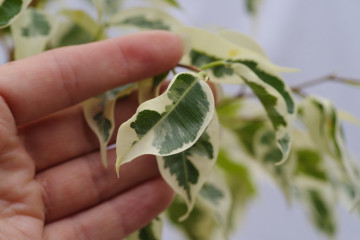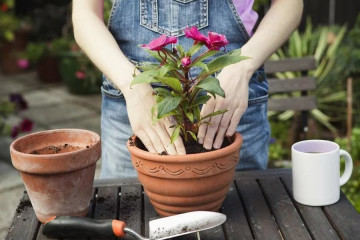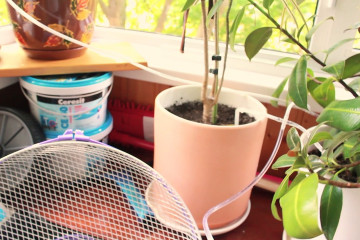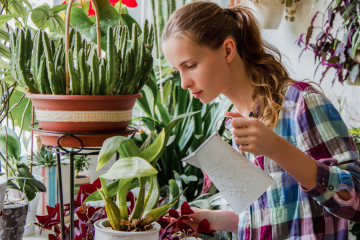Phytosporin for indoor plants: instructions for use
Content:
Chemicals used to fertilize the soil can not only benefit plants, but also cause great harm to the environment, animals and people. The development of environmentally friendly soil cultivation technologies has led to the creation of new fertilizers, including "Fitosporin", a microbiological preparation, the use of which has proven its effectiveness and allows you to completely abandon the use of chemicals for plant care.
The tool under the general name is produced in various variations, determined by its purpose. The whole group of drugs is united by the presence in the composition of the same active substance, and is distinguished by the presence of different biological additives.
"Fitosporin" is successfully used for indoor plants.
Description of the drug
When the agent is on the plant, the bacteria in its composition begin to actively multiply and destroy harmful microorganisms. The enzymes produced by bacteria act on putrefactive processes, stopping them and promoting the decay of rotten tissue. At the same time, the cells of the Bacillus subtilis culture synthesize vitamins, amino acids, contributing to the growth and development of plants.
Main positive properties:
- destruction of harmful microorganisms and rot;
- increasing plant immunity, resistance to the development of diseases;
- improved adaptability, faster engraftment during transplantation;
- increased endurance with temperature fluctuations and the presence of other unfavorable factors.
Composition and form of release
A unique tool has been developed and produced by a domestic manufacturer - the Ufa company "BashInkom". It is based on living spores and cells. This is a natural culture of Bacillus subtilis 26D, belongs to the group of biofungicides, capable of retaining its properties for a long time. If conditions for existence become unfavorable, it quickly turns into disputes.
In addition to the active substance, the composition of "Fitosporin" may contain additives: GUMI (made from brown coal and contains nitrogen), phosphorus and potassium (used to form and protect the root system); trace elements, chalk, etc.
Release forms:
- Grayish or white powder. Packing - 10-300 g. Differs in long-term storage without loss of useful properties, but it is necessary to wait a long time for its dissolution;
- Dark, thick paste. Packing - 10-200 g. Easy to dilute in water;
- Liquid. Ideal for indoor plants due to its gentle effect. Packing - up to 10 liters. Not subject to freezing.
Dilution options for the drug
The use of "Fitosporin" is possible only in liquid form, since bacteria are not activated in a dry state. However, there are different breeding methods for different forms of release:
- The powdery preparation is diluted in a ratio of 1 tablespoon to 1 liter of liquid;
- A 50% solution is prepared from the paste, that is, 200 ml of water is taken for 100 ml of "Fitosporin". From the resulting concentrate, an aqueous solution is then prepared for treating the plant, using different dosages (dropwise) depending on the purpose of use.
After dissolving the powder or paste, the liquid must be allowed to stand for a couple of hours for the bacteria to become active.
If "Fitosporin" is purchased in liquid form, it means that it is already a concentrated solution, dilute it for further use according to the indicated dosage.
Instructions for use
By purchasing "Fitosporin M", it is necessary to study the instructions for use for indoor plants. There are indicated the doses of the drug, methods of processing and methods of safe use of the drug.
Precautionary measures
If "Fitosporin" comes into direct contact with mucous membranes, it can provoke itching and slight irritation. Therefore, when working with the drug, you must follow the safety rules:
- Wear silicone gloves;
- During the processing period, it is not allowed to eat and drink, smoke;
- When spraying, use eye protection (goggles) and do not allow the product to enter the respiratory tract (wear a respirator or cloth mask). In the summer, it is better to take the plant out of the room into the open air (but not in the sun!);
- Do not prepare drug solutions in food containers;
- If "Fitosporin" gets on the skin or mucous membranes, they are thoroughly washed with a stream of water;
- If it enters the stomach, rinse it, causing vomiting, and take activated charcoal tablets;
- After use, wash hands, face, neck with soap and water;
- Store the product in places where access for children and pets is difficult.
How to handle correctly
The bacteria-based product can be used for all types of indoor plants, including the effective "Fitosporin" for orchids. The main purposes of using the drug:
- Plant healing;
- Preventive treatment in order to prevent the occurrence of diseases;
- Seed soaking;
- Use for processing cuttings;
- Preparing the soil before planting seeds.
Indoor plants can be treated by watering the soil and spraying. Watering regime - monthly. For diseased plants, treatment should be carried out 2-3 times a week.
If "Fitosporin" is used for orchids, then there is a difference in how to use it for watering. The pot with the orchid is immersed in a large container filled with a solution of the drug, and after 15-20 minutes it is pulled out.
When resuscitating orchids, a solution of "Fitosporin" is prepared, the roots are immersed in it after washing and cutting off dead and decayed parts.
Soaking the seeds before planting also has a beneficial effect on disease prevention.
Dosage
For indoor plants it is not recommended to purchase "Fitosporin" in the form of powder or paste. They are intended more for use in orchards and vegetable gardens.
The correct dosage depends on the purpose of using the drug. Basic Rules:
- "Fitosporin" in bottles: 10 drops per glass of water - preventive spraying and watering, 20 drops per glass of water - when treating diseased plants;
- Paste: 10 drops of concentrate (50% paste solution) per 1 liter of water - for spraying, 15 drops per 1 liter - for irrigation, 4 drops per 0.2 liters - soaking cuttings and seeds on the eve of planting (time - 2 hours. );
- Powder: 1.5 g per 2 l - prophylaxis, per 1 l - treatment during treatment.
There is no difference how to dilute Fitosporin specifically for orchid treatment. This is done in a similar way to other indoor plants.
Further care of the plant
There is no need to apply any special measures after using "Fitosporin" to plants. However, after irrigating the soil with the drug, especially in cases of need to act on fungal infections and harmful microorganisms, it is not recommended to irrigate with plain water until the soil dries up.
After the treatment, "Fitosporin" is used only as a prophylactic agent.
The working solution must be stored for some time, but the maximum effect from the use of the drug can be achieved only with immediate processing.
"Fitosporin" is an effective remedy, but it is intended mainly to prevent the occurrence of fungal and bacterial diseases; chemical preparations may be required to treat advanced cases. Even in the case of using "chemistry" "Fitosporin" will come in handy, as it will help restore plants.
Video





















